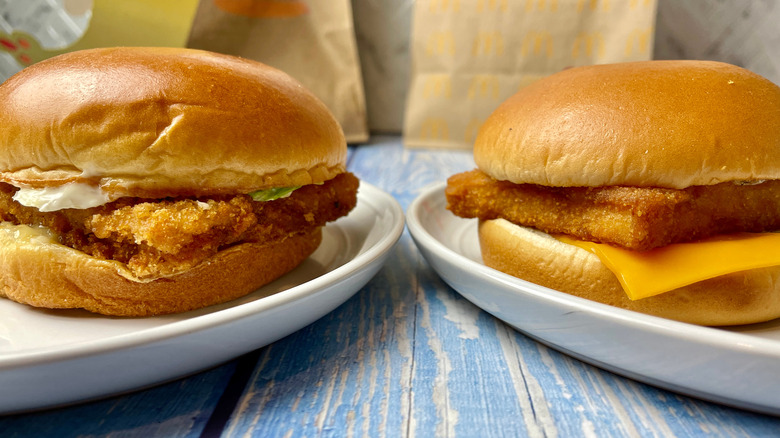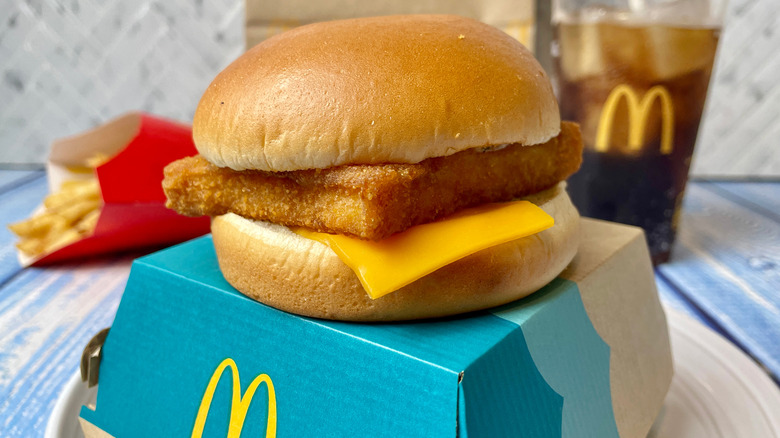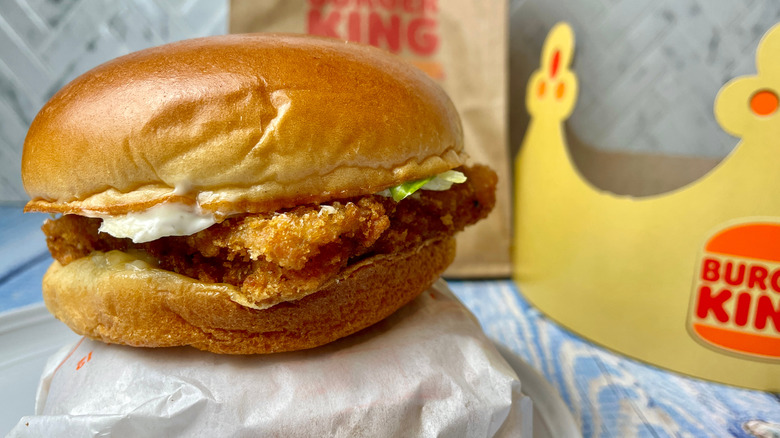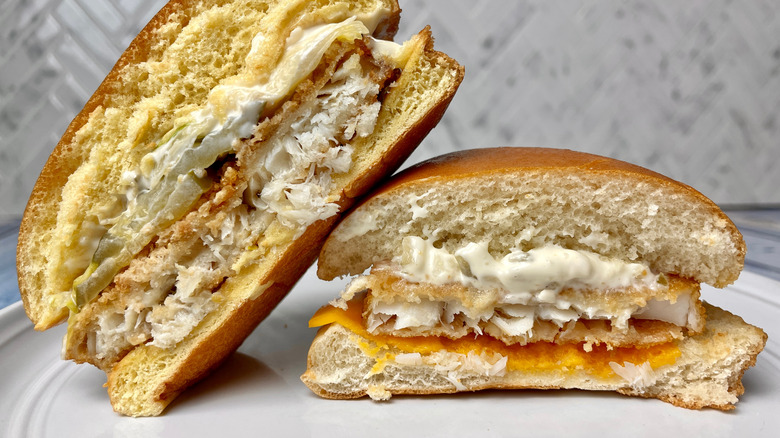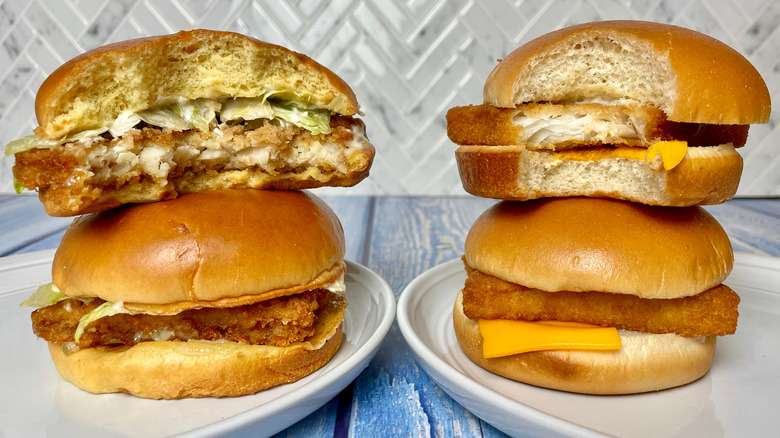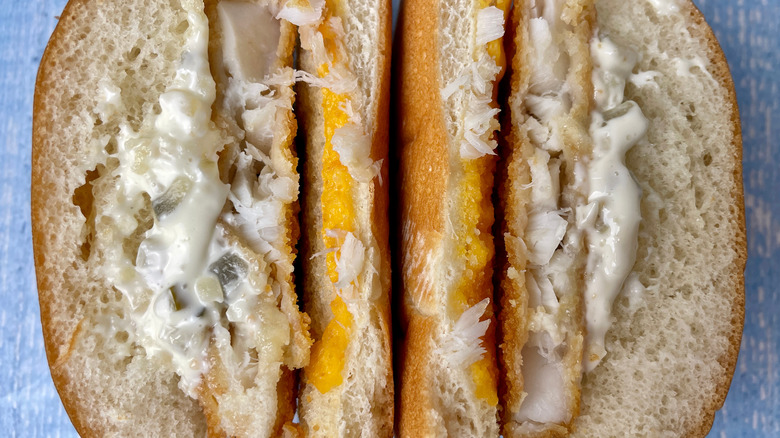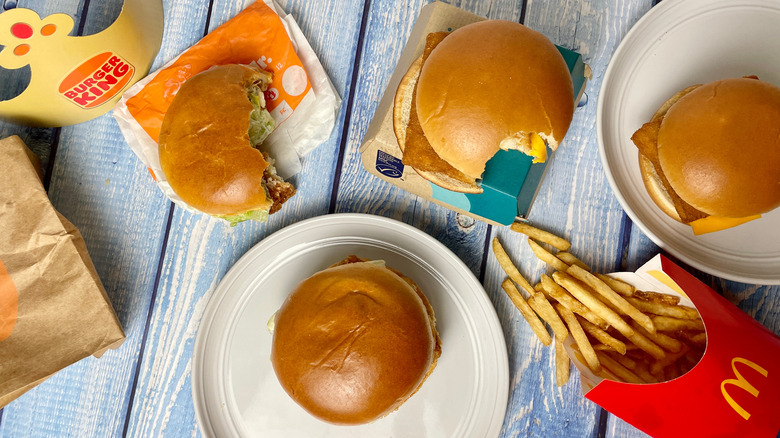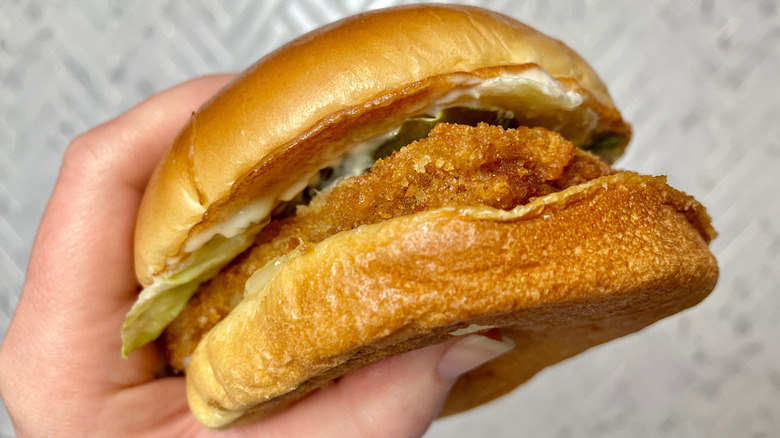McDonald's Filet-O-Fish Vs Burger King's Big Fish Sandwich: Which Is Better?
For many, the fried chicken sandwich wars are the World Cup of alternative fast-food sandwiches. But the lesser-known fish sandwich wars are equally competitive with an even longer history for many restaurants. Unfortunately, not every restaurant offering fish sandwiches keeps them on the menu year-round. Many restaurants bring fish sandwiches out in the spring, heading into the Lenten season, which typically begins in February. According to McDonald's, the chain sold 25% of the year's Filet-O-Fish sandwiches during the 40-day liturgical season in 2015 since many Catholics tend to consume more fish on Fridays and throughout the spring. So if you've fallen in love with a fish sandwich from Popeye's or Arby's in March, you might find yourself without as many options in November — which is where playing the long game pays off for McDonald's and Burger King.
Both restaurant chains cook fish sandwiches year-round and have included them on the menu for several decades, making them the original options for anyone looking for an alternative to a beefy cheeseburger. To find out which of these two permanent menu fish sandwiches is better, even in the dead of winter, I tasted both the McDonald's and Burger King offerings side-by-side and then took into consideration the price, nutritional information, and coordinating menu options to find the winner. As someone who gladly indulges in a McDonald's or Burger King cheeseburger with equal enjoyment, I went into this taste test without any significant bias or expectations. Here's which fast-food fish sandwich is the best.
McDonald's Filet-O-Fish sandwich
First on the scene was the Filet-O-Fish from McDonald's, which was created in 1962 specifically to serve Catholic customers who ate fish on Fridays during Lent. It's been a staple on the McDonald's menu ever since and is currently the only fish offering from the chain fast food restaurant. It was released in 1965 and cost only 29 cents per sandwich — while the price has certainly gone up, the basic structure of the sandwich hasn't. The Filet-O-Fish is still made with a square fried fish patty and tartar sauce but now includes a steamed-to-order bun that's more tender than the typical burger buns. The current sandwich also includes half a slice of American cheese.
In recent years, other fast food chains have developed their own versions of the fried fish sandwich, but the Filet-O-Fish remains incredibly popular, selling roughly 300 million sandwiches per year. For an idea of just how big of a deal that is, McDonald's sells about 550 million Big Macs over the course of an entire year, which is the chain's bestselling menu item behind its fries. With sales like that, it's no wonder the Filet-O-Fish is on the menu year-round.
Burger King's Big Fish sandwich
The fish sandwich from Burger King didn't really make a splash until the 1980s, although its first appearances are said to have been sometime in the 1960s and into the 70s, according to The Retroist. At the time, it wasn't referred to as the Big Fish sandwich, but The Whaler — which was later reintroduced in the 80's. One commercial even shows a Whaler box playfully swimming through the fog and scaring off a much smaller Filet-O-Fish sandwich. In the video, the Filet-O-Fish sandwich looks nearly identical to how it looks now, while the Whaler sandwich is large, with a sesame seed bun and filled with lettuce and tartar sauce.
The sandwich itself has changed several times in the last four decades, including the name. It's also been called the "Premium Alaskan Fish Sandwich," the "Ocean Catch Fish Fillet," and the "Extra Long Fish Sandwich," which had all of the same ingredients but longer. The version of the sandwich that is now the Big Fish sandwich hit restaurant menus in the 2000s and has remained relatively unchanged for the better part of the last decade. The sandwich is no longer served on a sesame seed bun but still includes tartar sauce and lettuce. It also now includes pickles, which previous versions didn't have. The Big Fish sandwich can be ordered solo or as a meal with a drink and a side and is available at Burger King restaurants everywhere.
The fried fish patty
At first glance, the fish patties in both the Filet-O-Fish and the Big Fish sandwiches look mostly identical. Both patties are made from Alaskan Pollock and cut into similarly sized, crisp, and slightly rectangular pieces. Neither are quite as substantial as they look in the promotional photos of the sandwiches on the restaurants' websites, but that wasn't especially surprising. Where the patties start to diverge is with the breading. If you're familiar with both the McDonald's and Burger King chicken nuggets, you might recognize a similar breading style on each of the fish sandwich patties. The Filet-O-Fish patty has a thinner, smoother breaded crust, while the Big Fish patty has a more textured and crunchy breaded crust. Burger King says the breading is a panko crust but doesn't include an itemized ingredient list to compare to the McDonald's filet.
The difference in breading seems to translate into a slightly thicker and crunchier breaded fish filet in the Burger King sandwich, and a slightly more delicate breaded filet in the McDonald's sandwich. As far as the fish itself goes, the pollock tastes exactly the same on both sandwiches — not overwhelmingly "fishy," but still noticeably a white fish sandwich. Ultimately, the differences between the fish patties are minimal and would be hardly noticeable if switched. But if you're a diehard chicken nugget fan from either of these two restaurants, the signature breading styles might be the most important factor for you here.
The buns
The bun might seem like the least important part of the sandwich, but a bad bun can ruin a whole meal. Luckily, neither of these sandwiches is made with what I'd consider a bad bun. They were both tender and fresh-tasting, not too dense or airy. The ratio of bun to fish and toppings was appropriate — at no point did I end up with a mouthful of bread, nor did the fillings overwhelm the bun. The Big Fish bun has a toasted brioche-style bun, and McDonald's describes the Filet-O-Fish bun as a soft, steamed, regular bun. The Burger King buns are a little larger than the McDonald's buns in diameter but not noticeably larger in height. The bread has a yellow tint, similar to what you'd see with a brioche bun, while the McDonald's bun looks more like white bread.
There isn't a current itemized ingredient list available for the Burger King bun. However, a previous nutrition information chart from 2015 lists the main ingredients as unbleached enriched flour, water, high fructose corn syrup, yeast, dried honey blend, and soybean oil. When compared with the current McDonald's regular bun ingredient list, there are only two differences. The McDonald's bun lists sugar instead of high fructose corn syrup (although it doesn't specifically define it as cane sugar) and omits the dried honey blend. Otherwise, they're exactly the same, and it seems like the Burger King bun likely gets its yellow tint from the additional dried honey blend.
The toppings
Both of the fish sandwiches from McDonald's and Burger King come with a few toppings each, but I didn't realize that they'd be quite as different as they are. The Big Fish sandwich from Burger King is dressed with tartar sauce on both the top and bottom buns, pickles, and lettuce. McDonald's went in a slightly different direction with the Filet-O-Fish, adding only tartar sauce and half a slice of American cheese to each sandwich.
When I opened the Filet-O-Fish to look at all the ingredients, I was a little shocked. Not by the fact that there was cheese on the sandwich (I'd eat cheese on just about anything), but because there's only half a slice of cheese, which wasn't even really centered on the bun. After double-checking the menu to make sure that my restaurant wasn't just experiencing an American cheese shortage, I couldn't help but think that the sandwich seemed under-dressed — and, frankly, a little cheap.
With that said, both sandwiches come with customizable options, including an extra half slice of cheese for the Filet-O-Fish, as well as bacon, pickles, lettuce, and tomato, all available for an additional charge. On the Big King sandwich, you can add cheese, bacon, onion, and tomato. Both restaurants also offer additional sauces, like ketchup, mustard, mayo, and BBQ sauce, for no extra charge. So technically, you can dress your sandwich up or down however you like it at either restaurant if you're willing to pay for it.
Comparing nutritional differences
A quick glance at the nutritional information for both fish sandwiches shows just how different they really are. The Filet-O-Fish has fewer calories overall, 390 calories in all, whereas the Big Fish sandwich has 570 calories. Given that the Filet-O-Fish has 38% fewer calories, it's not surprising that many of the other nutritional metrics are also lower. It's got 19 grams of fat, 39 grams of carbohydrates, 16 grams of protein, 30 mg of cholesterol, and 580 mg of sodium. In comparison, the Big Fish sandwich has 30 grams of fat, 58 grams of carbohydrates, 19.2 grams of protein, 50 mg of cholesterol, and 1,270 mg of sodium.
I was surprised and mildly impressed to see double-digit protein numbers for each sandwich but less enthusiastic about the amount of sodium in the sandwiches — especially for the Big Fish sandwich. If 1,270 mg of sodium sounds like a lot, it's because it is. According to the American Heart Association, 2,300 mg of sodium should be the maximum amount of sodium intake for adults per day, with an ideal limit of just 1,500 mg for the best heart health and blood pressure. That means that one Big Fish sandwich is a little over half of the maximum sodium intake for an adult each day and nearly the entire ideal daily amount. Sure, the salt is part of what makes it taste so good, but not so good that I'm planning on making it a daily meal choice.
The price difference
The price of one of these fish sandwiches may vary depending on where you're located, but I went to the restaurants in person to order each of the sandwiches to get an idea of the baseline prices in my area (New York City). At Burger King, a single Big Fish sandwich costs $6.39 before taxes, and the regular Big Fish meal costs $9.99. Over at McDonald's, the Filet-O-Fish sandwich costs $5.49 before taxes, and the medium Filet-O-Fish meal costs $9.59. Each meal includes french fries (or onion rings at Burger King) and a fountain drink. So, generally speaking, there isn't a huge price difference between the two sandwiches and fish sandwich meals. After seeing that the McDonald's sandwich is noticeably smaller than the Burger King sandwich, the lower price at McDonald's seems like a justifiable markdown.
If ordering from either restaurant online through a delivery service like Uber Eats or Seamless, the prices of the individual items will likely be higher, and there will also be additional fees. A Big Fish sandwich from the same restaurant location costs $7.99 through Uber Eats, and the regular meal costs $13.59—all before taxes, delivery fees, service fees, and a driver tip. If ordering from the same McDonald's through Uber Eats, the Filet-O-Fish sandwich costs $6.89, and the medium combo meal costs $11.99 before taxes and additional delivery charges. Naturally, ordering larger-sized meals will be an additional cost when ordering online and at a restaurant in person.
Availability and additional options
You'll be able to find both the Filet-O-Fish and Big Fish sandwiches on the menu year-round, but there are a few limits to keep in mind when ordering. Some McDonald's locations that are open late or for 24 hours might not offer the Filet-O-Fish after midnight. This might be due to a more limited staff, fewer fryers in operation, or the need to start turning the kitchen over for breakfast service. The Burger King location I ordered from serves the Big Fish sandwich on the restaurant's late-night menu, but that might not be the case at every location.
These are currently the only fish options on either restaurant's menu, although a few variations of the Filet-O-Fish are available in some locations. Some menus list a Double Filet-O-Fish, which comes with two fish patties, a whole slice of American cheese, and presumably, a little more tartar sauce. In some locations across Maryland and the D.C. metro area, the Old Bay Filet-O-Fish has been offered with an Old Bay-infused tartar sauce, which occasionally returns to the menu. A few brave souls have courageously ordered a Filet-O-Fish patty on a regular burger (referred to as a "surf and turf"). And even more baffling, a burger, Filet-O-Fish patty, and a McChicken patty for a three-beast feast sandwich. You won't find that on the menu anywhere, but if you're feeling adventurous, head to McDonald's during a quiet time and politely ask the server for one; you might just get it.
Final Verdict: The Big Fish is King
As far as fried fish sandwiches go, neither of these options is what I'd consider the best of the best. But since much of the competition doesn't sell fish sandwiches for half of the year, having them as options is nice. So much about these sandwiches is essentially the same — from the nearly identical Alaskan Pollock fish patties to the only slightly different buns — the deciding factor was really the toppings, which the Burger King Big Fish sandwich supplied with far more generosity than the McDonald's Filet-O-Fish.
It's a good start that both sandwiches include tartar sauce, although more or less is up to you. But I strongly believe that fried sandwiches, whether chicken, fish, or something else entirely, should include pickles. It makes no sense that every McDonald's burger and the regular McCrispy chicken sandwich comes with pickles, and the Filet-O-Fish does not. And even though I'm fine with the addition of American cheese to the Filet-O-Fish sandwich, I'm confused why it was added instead of pickles. Finally, is it too much to ask for a little bit of lettuce on the Filet-O-Fish sandwich? Sure, both of the sandwiches can be customized, but the Big Fish sandwich is one that might require few, if any, customizations to perfect. The Filet-O-Fish practically demands additional toppings (all at an additional cost). I'd rather pay the extra 90 cents up-front and get a sandwich that I'm actually going to enjoy straight off the menu.
